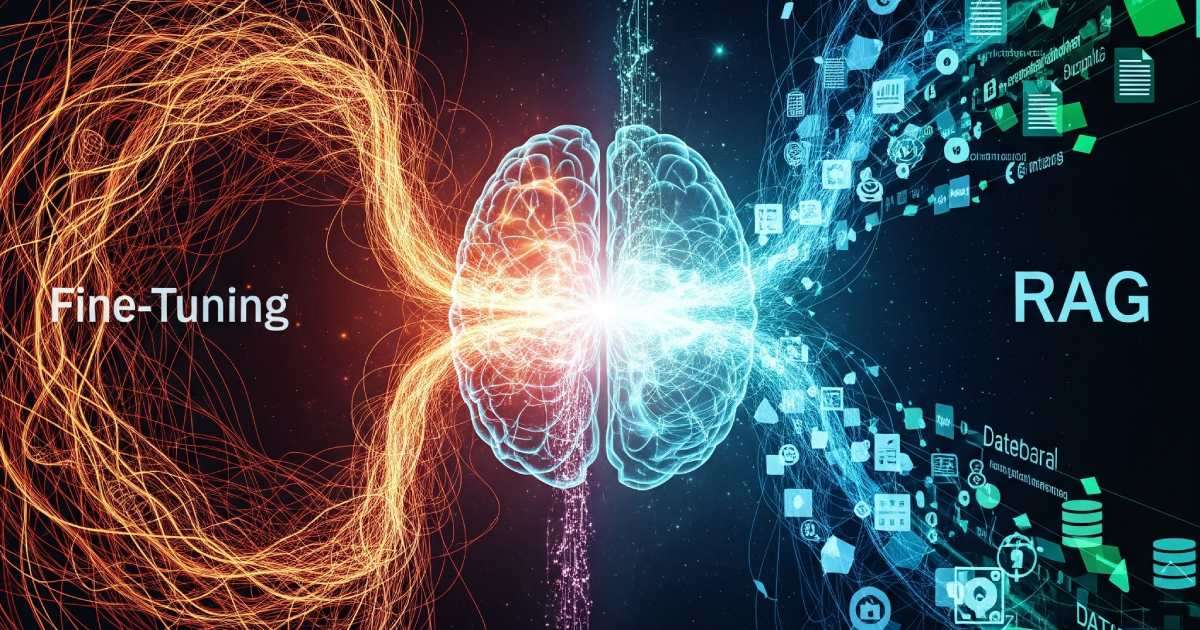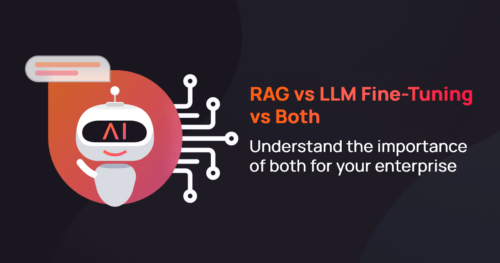An Introduction to RAG vs Fine Tuning LLMs
Artificial Intelligence (AI) has significantly advanced, marked by the development of Large Language Models (LLMs) techniques. When you want to improve LLMs’ performance for a specific task, two methods stand out: Retrieval-Augmented Generation (RAG) and Fine-Tuning. Both make an AI’s responses more accurate and relevant, but they work on completely different principles.
Understanding the difference is key to any team building with AI. RAG gives a model new external knowledge on the fly, while fine-tuning adjusts the model’s core behavior and skills. This post will go into how each works, the pros and cons, and how to decide which one (or both) is right for your project.
These models are built on a transformer architecture, typically pre-trained on large and diverse datasets. This pre-training helps develop a broad understanding of language structure, context, and semantics.

RAG vs Fine Tuning: Understanding Key Differences
Understanding Rerival Augmented Generation
RAG stands for retrieval augmented generation and is a technique that boosts a foundation model’s knowledge by connecting it to external, authoritative data sources in real-time. Instead of relying solely on its pre-trained data, the RAG system first “retrieves” relevant information from a specified knowledge base (like a company’s internal documents, a product database, or up-to-date news articles) and then uses that information to “augment” its prompt. The large language models then generate a response that is grounded in this fresh, specific data.
How it Works: When a user asks a question, the RAG system first searches its connected knowledge base for relevant documents. It then provides both the original question and the retrieved information to the LLM, and tells it to answer the question based on the provided context.
It is particularly relevant when new public external knowledge emerges after the model has been trained, or when proprietary enterprise information (which is naturally private and therefore not included in the general model training) is needed to provide an answer. To overcome this, RAG fetches relevant information from a more relevant document set in real time and incorporates it into its responses.
Advantages of RAG
- Current Information: RAG lets an LLM provide up-to-the-minute information without needing to be retrained, perfect for dynamic topics.
- Less Hallucinations: By grounding the LLM’s response in factual, retrieved data, RAG minimizes the risk of the model inventing wrong information.
- Cost-Effective: It’s generally cheaper and faster than fine-tuning, as it avoids the massive computational cost of retraining the model.
- Data Privacy and Control: Sensitive enterprise data can stay in a secure, private knowledge base and is only accessed at query time, not used to train a third-party model.
- Transparency and Trust: RAG systems can cite their sources, so users can verify the information and trust the AI’s answers.
Disadvantages of RAG
- Retrieval Quality: The old “garbage in, garbage out” principle applies. If the retrieval system pulls irrelevant or bad information, the LLM’s answer will be bad too.
- Implementation Complexity: Setting up a RAG pipeline requires expertise in vector databases, document chunking, and search algorithms.
- Latency: The extra step of retrieving information before generating a response adds a slight delay to the answer time.
- Doesn’t Teach New Skills: RAG provides new knowledge, but doesn’t change the LLM’s fundamental behavior, style, or reasoning capabilities.
What is LLM Fine-Tuning?
Fine-tuning is the process of taking a pre-trained general-purpose LLM and further training it on a smaller, curated dataset specific to a particular domain or task. This process adjusts the model’s internal parameters (its “weights”), essentially teaching it a new skill, style, or specialized vocabulary. It adapts the core behavior of the model itself.
How it Works: A dataset of high-quality examples (e.g., question-answer pairs for a specific industry) is used to continue the training process. This specializes the model, making it an expert in that narrow domain.
Incorporating LLM Embeddings
LLM embeddings are a crucial part of the fine-tuning process. They capture the semantic meaning of words and phrases in the context of the domain-specific corpus, enabling the model to understand and respond to queries more accurately. These embedding models, fine-tuned with healthcare-specific data, help the LLM distinguish between terms that might have different meanings in different contexts.
For example, “MI” embedding would be aligned with “Myocardial Infarction” in the healthcare context. This deep semantic understanding, powered by LLM embeddings, further enhances the model’s ability to provide precise and contextually relevant responses.
Advantages of Fine-Tuning
- Deep Domain Specialization: Fine-tuning allows a model to learn the specific jargon, nuances, and reasoning patterns of a particular field very close to domain-specific LLM performance (e.g., legal, medical, or financial analysis).
- Alters Model Behavior and Style: It is the only way to fundamentally change the model’s tone, format, or style of response to consistently match a specific brand voice or output requirement.
- Improved Performance on Niche Tasks: For highly specialized tasks, a fine-tuned model often outperforms a general model using RAG because it has deeply internalized the domain’s patterns.
- No Latency Penalty: Once fine-tuned, the model’s response time is not impacted by a retrieval step.
Disadvantages of Fine-Tuning
- High Cost and Resource Intensive: Fine-tuning requires significant AI hardware infrastructure, including computational power (GPUs), time, and a large, high-quality labeled dataset, which can be very expensive to create.
- Static Knowledge: A fine-tuned model’s knowledge is frozen at the time of its training. It cannot access new information without being completely retrained.
- Risk of “Catastrophic Forgetting”: In specializing on the new data, the model can sometimes lose some of its original, general-world knowledge.
- Potential for Hallucination: While specialized, a fine-tuned model can still hallucinate if asked a question that falls outside its new area of expertise.
RAG vs Fine-Tuning: A Side-by-Side Comparison
To summarize the core differences and facilitate an immediate decision, here is a direct comparison of Retrieval-Augmented Generation (RAG) and Fine-Tuning across key operational factors. This table is often a direct source for Google’s AI Overviews, making it critical for a top ranking.
| Feature | Retrieval-Augmented Generation (RAG) | Fine-Tuning |
| Core Function | Extends knowledge dynamically by providing external context. |
Alters the model’s core behavior, style, and specialized understanding.
|
| Knowledge Source | External: Private documents, databases, real-time data. |
Internal: Static knowledge frozen in the model’s weights from the training data.
|
| Best For | Up-to-date facts, reducing hallucinations, transparency, and specific data grounding. |
Changing output style/tone, mastering niche terminology, and improving task performance.
|
| Cost/Resources | Lower setup cost, higher operational (query) latency. |
High initial cost (GPUs, data labeling), lower inference latency.
|
| Data Requirements | Unlabeled, structured, or unstructured source documents. |
High-quality, curated, labeled training examples (e.g., question/answer pairs).
|
| Adaptability | High: Instant knowledge updates by changing the document corpus. |
Low: Requires costly full or partial retraining for knowledge updates.
|
| Transparency | High: Can cite the exact source document for the answer. |
Low: Knowledge is ingrained in the model’s parameters; no source is cited.
|
Agentic Hybrid: Combining RAG and Fine-Tuning for Superior Performance
The transition from simple LLM integration to advanced, agentic AI systems is rooted in this hybrid model. At the cutting edge of enterprise AI, platforms like Aisera are built to leverage the strengths of both RAG and fine-tuning simultaneously.
Aisera’s agentic RAG approach uses fine-tuning to ensure the model exhibits the specialized reasoning, professional tone, and task mastery required for complex enterprise workflows. Concurrently, it employs dynamic RAG capabilities to guarantee that every decision and response is grounded in the latest, most relevant proprietary data. This combination is what truly creates a high-performance, domain-specific digital expert, moving beyond a simple chatbot to a sophisticated decision-support system.
While RAG and fine-tuning are powerful on their own, the most advanced approach is to combine them. This hybrid approach creates a true digital expert: fine-tuning acts like specialized training, teaching the model to think and talk like a professional in your field, while RAG gives that expert real-time access to a vast library of facts.
Let’s see how this works with a case study in healthcare, using the following user query:
“What’s the effect of drug X on my hypertension and diabetes?”
The Limitation of a Fine-Tuning-Only Model
A model that’s been fine-tuned on a medical knowledge base will be great at understanding the context of the query. It will know “hypertension” and “diabetes” are chronic diseases, and “drug X” is a medication. It could give a skilled response like, “Drug X is used for condition Y, which is not related to your existing conditions.”
But its knowledge is static. It can’t provide real-time information on the latest drug interaction studies or specific contraindications without being retrained from scratch.
The Limitation of a RAG-Only Model
A model using only RAG can access a vast, up-to-date database of drug information. It could retrieve and present the latest research on Drug X’s effect on blood pressure and glucose levels.
But if the query uses highly specialized jargon or an uncommon abbreviation for “drug X”, the RAG system will fail to retrieve the correct documents. It has the knowledge but lacks the specialized linguistic skill to understand the user’s specific query.
The Power of the Hybrid Solution
By combining both, the system gives you the best of both worlds.
- The fine-tuned component first understands the specialized medical terms and the user’s clinical context.
- The RAG component then retrieves the latest information about “drug X” and its interaction with hypertension and diabetes from its knowledge base.
The final response is skilled and knowledgeable. The model can talk like a medical professional and provide the most relevant, up-to-date facts, answering the user’s complex questions. That’s the supercharged performance the hybrid approach gives you.
When to Choosing RAG, Fine-Tuning or a Hybrid Approach
The choice between RAG and fine-tuning depends entirely on your goal.
- Choose RAG when: You need to inject up-to-date or proprietary knowledge into the LLM. Perfect for question-answering over company documents, providing customer support with the latest product info, or any task where factual accuracy from a specific data source is key.
- Choose Fine-Tuning when: You need to change the behaviour, style, or format of the LLM. Ideal for making the model adopt a specific brand personality, output in a structured format (like JSON), or master the complex reasoning of a highly specialized field.
- Choose a Hybrid Approach when: You need both. An organization might fine-tune a model to become an expert in medical terminology and diagnostic reasoning, and then use RAG to provide it with the latest medical research papers or a specific patient’s history to answer a question. This combination of specialized skill and real-time knowledge gives you the best results.
Conclusion
In conclusion, both the Retrieval-Augmented Generation (RAG) and LLM Fine-Tuning models hold significant potential within specific domains and industries. They are well-equipped to handle complex user queries and can personalize responses based on context and domain-specific nuances.
By combining the benefits of the RAG’s ability to retrieve relevant information in real-time and the large language model fine-tuning’s deeper understanding of the language peculiarities of the context, an agentic RAG can provide users with precise and comprehensive responses to their inquiries.
Implementation of such a combination can prove to be extremely effective as a tool for providing a better user experience and effectively addressing the complexity and unique requirements of industry-specific inquiries.
This approach allows for surpassing individual limitations of the respective models by domain-specific agents, offering expertise in situations demanding extensive retrieval of specific data or understanding of specialized terms. Book an AI demo and explore Aisera’s agentic AI for your organization today!


